DmC: Devil May Cry – Review
by Keegan
|
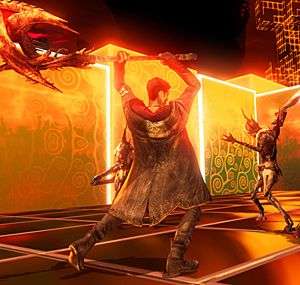 I almost always struggle to write the first sentence of a review. Generally that’s because I want to capture the tone of the game and give an impression of how I felt about it right from the start. The issue this time however, is that there is so much that I want to rave about with Devil May Cry, and I don’t know where to start. It’s generally accepted that the beginning is one of the better places to do so, so why don’t we go with that. No time is wasted in introducing the antagonist, Mundus. This guy is one bad cookie, seeing as he is the demon in charge of, well, everything. As Kyle Ryder (his human incarnation) he has bought and sold his way to ownership of everything, and through his monetary might allied to a myriad of political influences that he controls, he manipulates the human world to his purposes. Mundus has a nasty penchant for eating hearts, as he threatens to do to Dante. How else would we know that he is the bad guy?
I almost always struggle to write the first sentence of a review. Generally that’s because I want to capture the tone of the game and give an impression of how I felt about it right from the start. The issue this time however, is that there is so much that I want to rave about with Devil May Cry, and I don’t know where to start. It’s generally accepted that the beginning is one of the better places to do so, so why don’t we go with that. No time is wasted in introducing the antagonist, Mundus. This guy is one bad cookie, seeing as he is the demon in charge of, well, everything. As Kyle Ryder (his human incarnation) he has bought and sold his way to ownership of everything, and through his monetary might allied to a myriad of political influences that he controls, he manipulates the human world to his purposes. Mundus has a nasty penchant for eating hearts, as he threatens to do to Dante. How else would we know that he is the bad guy?
Our introduction to Dante is similarly turbulent, simply because when we see him for the first time he is drunk and in a strip club. Now, though this may seem like a rather scabby way to introduce a main character, it goes far beyond that. It lays the foundations for an exploration of Dante’s character that continues as we begin to learn his backstory and motivations. For a hack and slash game, Devil May Cry is rather story heavy, and as you work your way through each level your progress will be pockmarked with short cutscenes. Thankfully they never feel like an intrusion, often sequencing seamlessly into the action and providing opportunity for a short breather while they play out. They also seldom serve the same purpose twice; while some scenes act to further the story, others are simply there to show off Dante’s fighting skills in all their cinematic glory and others still set up or hint towards weaknesses that Dante can exploit in combat.
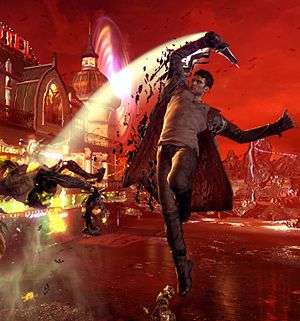 The story itself is fairly low key, but works its way up to conclusion that left my jaw dropped and stunned disbelief bubbling beneath the surface. It focuses on the influences of Mundus and the opposition that he faces, in the form of The Order. They are led by Vergil, Dante’s brother, and are focused solely on defeating Mundus and ending his influence on the world. To this end they recruit Dante, who is a Nephilim – Son of an Angel and a Demon and the only being powerful enough to destroy Mundus.
The story itself is fairly low key, but works its way up to conclusion that left my jaw dropped and stunned disbelief bubbling beneath the surface. It focuses on the influences of Mundus and the opposition that he faces, in the form of The Order. They are led by Vergil, Dante’s brother, and are focused solely on defeating Mundus and ending his influence on the world. To this end they recruit Dante, who is a Nephilim – Son of an Angel and a Demon and the only being powerful enough to destroy Mundus.
From there Dante goes on a variety of missions designed to weaken Mundus’ hold over Limbo City and, by extension, the world. There is, for example, one segment where Dante sets out to stop production of Virility, the most popular energy drink on the planet. It is produced by the demons as a way of keeping the general populace quiet and is highly addictive. The parallels with drugs and cigarettes are clear, culminating in a battle with the secret ingredient of Virility – a succubus called Poison.
This kind of social commentary is not only common in Devil May Cry, it’s blatant. Thanks to the implementation of the idea of Limbo however, it never feels like it is meant as evangelical. Ninja Theory’s concept of Limbo is rather fantastic, presenting the player with a twisted version of the city that serves to highlight all of humanity’s flaws. The way that Limbo is perceived differs from person to person, so the harsh and distorted vision that the player sees is through Dante’s eyes, thus the almost constant social commentary not only feels like it works, but improves the atmosphere of Limbo immeasurably.
Of course, the atmosphere would mean little without a good set of visuals, and again DmC doesn’t disappoint. Limbo City looks is the model of a modern city. The moment Dante steps into Limbo on the other hand, it becomes a place of nightmares. Sure, it’s suddenly infested with demons after your blood, but the city itself is just as impressive – and bloodthirsty – as the demons and has some level of intelligence (and plenty of malevolence). As you attempt to traverse it, it finds ways to disrupt you time and time again, with floors dropping down into nothingness, alleyways that squeeze shut on you if you don’t move fast enough, ever lengthening stretches of cobblestone. Whenever you draw the attention of the demons, inky black spikes erupt from the walls, blocking your path until you defeat your enemies.
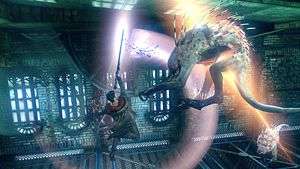 All of this is accompanied by a thumping soundtrack that is all electric guitar and heavy drumbeats, occasionally interspersed by bass heavy ambient tracks that can send shivers down your spine. Mundus’ theme in particular is a great example of how good the soundtrack is. The combination of music and visuals in some spots in Limbo are superb and, in fact, led to one of my favourite levels in recent memory: the strip club level. It’s a heady combination of neon lighting and dance tracks that will almost certainly get plenty of play in the coming months.
All of this is accompanied by a thumping soundtrack that is all electric guitar and heavy drumbeats, occasionally interspersed by bass heavy ambient tracks that can send shivers down your spine. Mundus’ theme in particular is a great example of how good the soundtrack is. The combination of music and visuals in some spots in Limbo are superb and, in fact, led to one of my favourite levels in recent memory: the strip club level. It’s a heady combination of neon lighting and dance tracks that will almost certainly get plenty of play in the coming months.
It is more than obvious that DmC is a game designed around replayability. The levels are fairly short, most of them taking only 15 or 20 minutes to get through, and at the end of each mission you are ranked on three facets of the game: Time, Completion and Style. Depending on how well you did you will receive a ranking of between D and SSS. The first of those is rather self explanatory – the faster you complete a mission, the higher your ranking. The idea time varies between missions, but if you complete the mission without taking too many detours you’ll likely have done well. However, high scores on the Completion do require more than a little exploring, as you have to find Keys and Doors hidden around the levels. You also need to find Lost Souls, who appear to be flayed and screaming constantly, and which can only released by hitting them with Dante’s sword, Rebellion. Like the Keys, they are generally hidden in nooks and crannies in the map that will require a bit of searching (and in some cases having to come back later) in order to find them all.
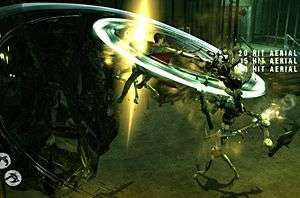 Style is your overall ranking for the combat throughout the mission; it tallies together all the points you’ve scored in the individual battles you’ve fought and gives a total ranking. The more you mix things up with different weapons and attacks, the more you score. The combat is designed around this concept, allowing plenty of options to dish out damage. At the heart of Dante’s style is his sword, Rebellion, and his twin guns, Ebony and Ivory, with Rebellion dishing out mid-powered, medium-speed attacks, and Ebony and Ivory serving to interrupt enemy moves and keep your multiplier up while you gauge your next move, as well as keeping an individual enemy in the air to be juggled.
Style is your overall ranking for the combat throughout the mission; it tallies together all the points you’ve scored in the individual battles you’ve fought and gives a total ranking. The more you mix things up with different weapons and attacks, the more you score. The combat is designed around this concept, allowing plenty of options to dish out damage. At the heart of Dante’s style is his sword, Rebellion, and his twin guns, Ebony and Ivory, with Rebellion dishing out mid-powered, medium-speed attacks, and Ebony and Ivory serving to interrupt enemy moves and keep your multiplier up while you gauge your next move, as well as keeping an individual enemy in the air to be juggled.
As Dante begins to explore his heritage he learns to use Rebellion in different ways, including turning it into completely different forms, which in turn fall into one of two classes: Angelic or Demonic weapons. Generally speaking two Angelic weapons, Aquila and Osiris, lay out fast, light hits that are often great for crowd control. Aquila works in broad sweeps, often hitting five or six enemies with a single input. Osiris, an angelic scythe, works better in densely packed groups, hitting quickly and flinging enemies into the air and keeping them there. Dante also has access to an Angel pull, which uses an enemy to move him towards that enemy and continue a combo. This is especially useful after launching enemies and for quickly chaining combos.
To contrast those there are the demonic weapons, Arbiter and Eryx. Both of these are far slower than the angelic weapons and Rebellion but deal greater damage, often concentrated on a single enemy. Arbiter takes the form of an oversized axe, and is used as you would expect, swinging slowly and only capable of short combos. Eryx works similarly, but has the ability to charge attacks, making them dish out even more damage. Dante has a demon pull, which, rather than pulling him towards an enemy, yanks an enemy towards him. In addition, all three demon weapons have the added ability to destroy shields, leaving once-shielded opponents vulnerable.
 The trick with combat is to combine all of these abilities, along with a dodge, to take down enemies as fast and efficiently as possible, while taking as little damage as you possibly can. Devil May Cry eases you into this idea, walking you through what you can do with each weapon individually when you first get it and providing you with ample opportunity to test each one out. It takes a little while to come to grips with, but soon becomes very fluid, as you can switch weapons mid combo, allowing for dozens of combinations and huge damage output. It’s also hugely impressive visually and immensely gratifying, especially as DmC is friendly enough to learn that weapons will be flying all over the screen.
The trick with combat is to combine all of these abilities, along with a dodge, to take down enemies as fast and efficiently as possible, while taking as little damage as you possibly can. Devil May Cry eases you into this idea, walking you through what you can do with each weapon individually when you first get it and providing you with ample opportunity to test each one out. It takes a little while to come to grips with, but soon becomes very fluid, as you can switch weapons mid combo, allowing for dozens of combinations and huge damage output. It’s also hugely impressive visually and immensely gratifying, especially as DmC is friendly enough to learn that weapons will be flying all over the screen.
DmC offers you plenty of enemies to beat the crap out of, ranging from slow, sword wielding foes to witches that fling demonic spears at you and can only be defeated after removing their shields. There are also huge titans that charge ferociously and can only be damaged from behind, brutish contraptions that fling sawblades, and some blind ninja-type things that can teleport and deflect all projectiles.
There are also boss fights scattered amongst the levels, during which you not only have to pile on and see how much damage you can inflict, but also fulfil secondary objectives to be successful. These are not always obvious, as proved by my lengthy final boss fight, but there are generally plenty of hints to let you know what you are doing. This also means that when you do miss something (like I did) and spend ages fighting a boss, you tend to feel that it’s your own fault. None of the bosses are hugely overpowered, and though they are clearly stronger than the other opponents you face it never feels like Dante is overmatched.
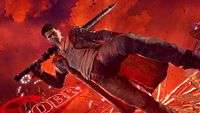 |
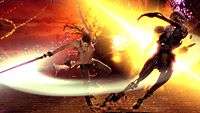 |
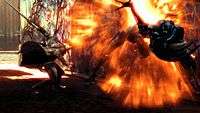 |
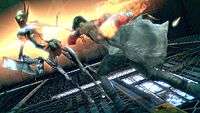 |
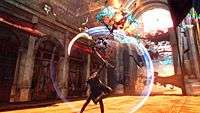 |
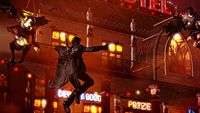 |
Taking on a beloved franchise and making it your own is perhaps one of the toughest, bravest (or most foolhardy) things a developer can do. The uproar from DMC stalwarts must have been incredibly discouraging from the brave souls over at Ninja Theory, but they stuck to their guns and in the end they were vindicated. They are a studio that is perhaps best known for the way that they develop characters and stories and, for me, this is perhaps the most impressive facet of this offering. I thoroughly enjoyed watching how Dante’s character grew from scruffy ne’er-do-well to saviour of the world, and also how his approach to the characters around him changes and grows from hugely antagonist to everyone – even his allies – to, well, play it and see.
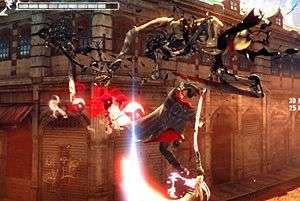 I was also impressed by the characters of Kat and Vergil, and how their development interwove with Dante’s. Together the three of them lifted what might have been a rather insignificant story to a brilliant one and by doing so lifted the game from very good to great. Best of all is the fact that though the campaign is on the shorter side of middling, there are a myriad of difficulties that make the game endlessly fresh and replayable. There are also a new mode called Bloody Palace set to make an appearance soon, which sends Dante climbing over a hundred levels of enemies and bosses, promising to turn into a timesink without peer. Best clear your calendar for that one.
I was also impressed by the characters of Kat and Vergil, and how their development interwove with Dante’s. Together the three of them lifted what might have been a rather insignificant story to a brilliant one and by doing so lifted the game from very good to great. Best of all is the fact that though the campaign is on the shorter side of middling, there are a myriad of difficulties that make the game endlessly fresh and replayable. There are also a new mode called Bloody Palace set to make an appearance soon, which sends Dante climbing over a hundred levels of enemies and bosses, promising to turn into a timesink without peer. Best clear your calendar for that one.
It’s not flawless by any means – there are occasional troubles with the camera, especially with enemies that move particularly quickly, and some of the platforming sections are iffy at times, but neither issue ever really felt like it affected my game. Sure, I fell once or twice – but that’s okay because I fell a ton all on my own – and the camera issues never resulted in my being hit because the sound design does an excellent job in letting you know when an attack is incoming.
There’s no such thing as a perfect game, but Ninja Theory have come pretty damn close. DmC is one of the most enjoyable game experiences that I’ve had in years. The combat is smooth and hugely enjoyable to engage in and watch unfold, and Limbo is spectacular and a pleasure to explore; best of all though, was watching the characters evolve and grow as the story opened up. This game is a triumph, and one that deserves to do well. There is a ruckus surrounding the changes that Ninja Theory have made, but it shouldn’t take away from what is a fantastic game in and of itself. I dearly hope that it does well, because I want to see where Ninja Theory goes next with this world and characters.
Pros- Deep, smooth and enjoyable combat system
- Characters that are fun to watch develop
- Endlessly replayable, with several modes changing the game up entirely
- Limbo is one of my favourite game worlds ever
- I actually really like Dante as a character
- The camera is occasionally iffy
- Some directional issues once or twice during platforming sections – I’m really nitpicking on this one
There are a lot of things to love about Devil May Cry. It’s fast paced, with combat that is fluid and hugely entertaining, and it looks absolutely brilliant, especially while you’re traversing Limbo.
Most of the time I’d recommend a game simply on the strength of those points, but DmC also has an enjoyable story and a wonderful group of characters to watch develop. Roaming Limbo putting the smackdown on demons is easily one of my best gaming experiences of the last 18 months, and there will no doubt be plenty more of it over the next few months as I work my way through each of the difficulty levels. This is a triumph for Ninja Theory and Capcom, and wonderful hack 'n' slash.
Last five articles by Keegan
- I Heart... Quiplash
- What's a Blood Sport Without Personality?
- XCOM and the Art of Permanence
- Pokken Tournament - Review
- Failure to Launch



















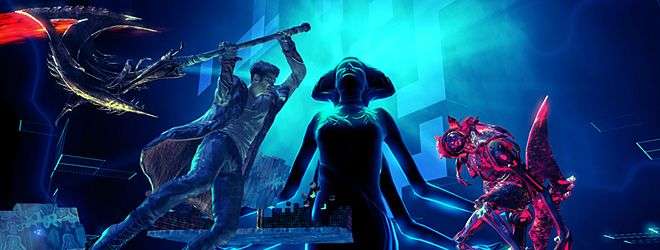
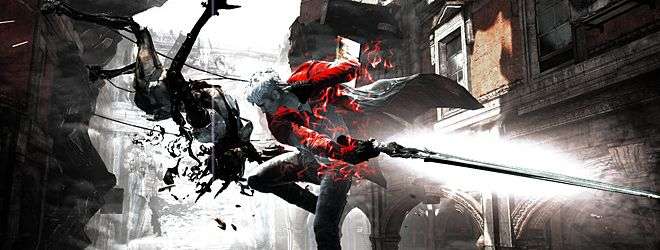






Really good review mate. I’m kind of a fan of the series, but only had the chance to play 1 and 4. Once I’ve played the others, I’ll certainly be picking this up! Very well written.
Decided to give it a shot because of this and it’s been pretty goddamn fantastic so far
Brilliant review, senor Keegan!